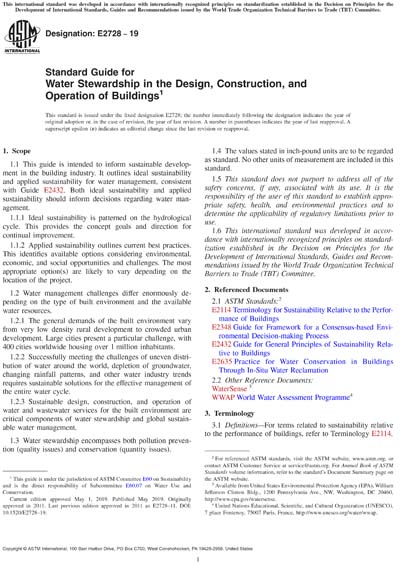Most recent
ASTM E2728-19
Standard Guide for Water Stewardship in the Design, Construction, and Operation of Buildings
1.1 This guide is intended to inform sustainable development in the building industry. It outlines ideal sustainability and applied sustainability for water management, consistent with Guide E2432. Both ideal sustainability and applied sustainability should inform decisions regarding water management.
1.1.1 Ideal sustainability is patterned on the hydrological cycle. This provides the concept goals and direction for continual improvement.
1.1.2 Applied sustainability outlines current best practices. This identifies available options considering environmental, economic, and social opportunities and challenges. The most appropriate option(s) are likely to vary depending on the location of the project.
1.2 Water management challenges differ enormously depending on the type of built environment and the available water resources.
1.2.1 The general demands of the built environment vary from very low density rural development to crowded urban development. Large cities present a particular challenge, with 400 cities worldwide housing over 1 million inhabitants.
1.2.2 Successfully meeting the challenges of uneven distribution of water around the world, depletion of groundwater, changing rainfall patterns, and other water industry trends requires sustainable solutions for the effective management of the entire water cycle.
1.2.3 Sustainable design, construction, and operation of water and wastewater services for the built environment are critical components of water stewardship and global sustainable water management.
1.3 Water stewardship encompasses both pollution prevention (quality issues) and conservation (quantity issues).
1.4 The values stated in inch-pound units are to be regarded as standard. No other units of measurement are included in this standard.
1.5 This standard does not purport to address all of the safety concerns, if any, associated with its use. It is the responsibility of the user of this standard to establish appropriate safety, health, and environmental practices and to determine the applicability of regulatory limitations prior to use.
1.6 This international standard was developed in accordance with internationally recognized principles on standardization established in the Decision on Principles for the Development of International Standards, Guides and Recommendations issued by the World Trade Organization Technical Barriers to Trade (TBT) Committee.
Content Provider
ASTM International [astm]






